
Structure and Architectural Details:
Scale:
Historically, the reconstruction of the usage and structure of the Mausoleum has been one of the most vexing problems facing scholars of ancient Roman historical topography. Since so little of the original structure remains, scholars have had to rely primarily on analogy to the Mausoleum of Augustus, and some sketchy numismatic and literary evidence.
As impressive as the Mausoleum of Augustus was, that of Hadrian was yet bigger, reaching a height of 50 meters at the top of its central tower (Boatwright 169). The footprint of the Mausoleum was a square, 115 meters on each side. Given these dimensions, it has been suggested that one of Hadrian*s goals was to outdo his older counterpart in every way possible (Claridge 371).
Architectural Details:
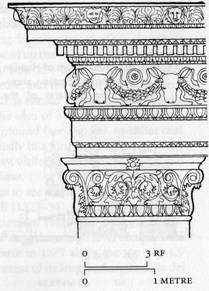
(Both Claridge 每 Column Capital and Frieze reconstruction)
Primarily, what distinguishes the Mausoleum of Hadrian from other tumuli is its large square base, which is the most original of what remains today (Boatwright 169). The base was supported by a very ornate wall of travertine-clad brick, with accents of Luna Marble (Boatwright 170). There is evidence of elaborate architectural decoration. Especially notable were the detailed corner columns of the base and relief work on the frieze above (Boatwright 170).
Layout and Floor Plan:
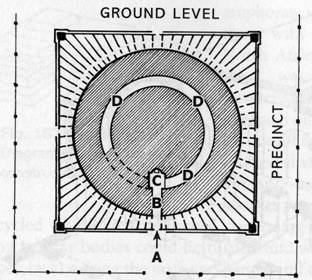
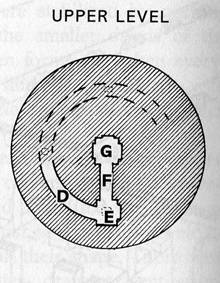
(Clardige 每 Reconstructed floor plan of the mausoleum)
Inside, the square base were 67 brick-lined chambers, each radiating from the center to the outer walls. The purpose of these chambers is largely unknown, although some have speculated that they were used for subsidiary burials (Boatwright 173). It is also possible that these radial brick walls were structural, providing necessary support to the massive structure above (Pierce 82).
The square footprint of the Mausoleum also allowed an unambiguous orientation of the structure with the cardinal directions (Pierce 87). It has been speculated that entrance was chosen to face south, so that natural illumination could be most effectively used inside the Mausoleum. This would have been significant given Hadrian*s self-declared association with the sun god (Pierce 87).
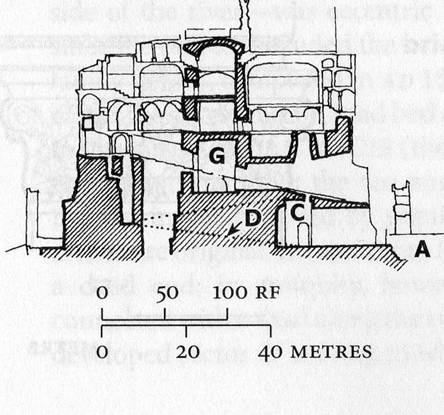
(Claridge 每 Profile of the Castel Sant*Angelo, the original Roman structure is hatched)
Above the square base was the central tower, which has been heavily changed by Renaissance-era building. Surviving evidence indicates that the interior was a mostly solid concrete structure penetrated by a single path.? A series of corridors, chambers, and a helical ramp, all lead to the large main burial chamber in the center of the drum, which rested 12 meters above ground level (Claridge 370 and Boatwright 172). This was a large space, perhaps 8 meters square, with recesses in 3 of the walls for the placement of ash urns (Boatwright 172). Ventilation and light were provided by a series of shafts that ran upwards to the exterior of the central drum.
Above the vaulted ceiling of the main burial chamber seems to have been another room (or two) which rose to the top of the central drum (Boatwright 172). Very little is known about the function of these rooms, or whether there were even accessible in antiquity.
Even more than the interior, the exterior of the central tower was almost entirely obliterated by the construction of the Castel Sant*Angleo (Pierce 81). Little remains except traces of the tufa and travertine that once faced the outside of the central drum (Pierce 85).
The Quardriga:
Literary evidence, especially the fragmentary writings of Dio Cassius, suggest that the top of the central drum was topped with a monumental sculpture, perhaps an enormous quadriga (four-horse chariot) (Boatwright 173). This would have been a very apt image, especially given the association of the quadriga with the Roman triumph, and tacitly, the deification of Hadrian, the rider.
Attempts at Reconstruction:
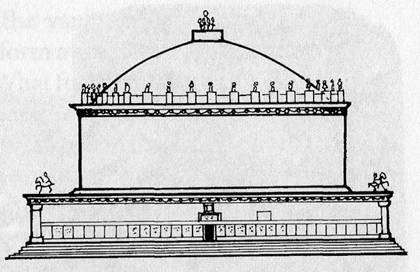
(Clardige 每 A conservative single tier reconstruction)
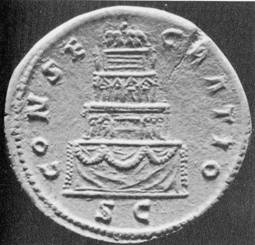
(Boatwright 每 A consecration medallion showing what has been identified by some historians as the Mausoleum of Hadrian)
Of the tentative reconstructions that have been attempted, the most conservative involve a single mound rising to form a statuary base (Boatwright 174). More complex reconstructions rely on a number of consecration medallions and the example of the Mausoleum of Augustus to reconstruct a four or five-tiered tumulus.
Unfortunately, despite such efforts, it seems that current evidence is simply not enough to resolve all of the questions surrounding the Mausoleum.
